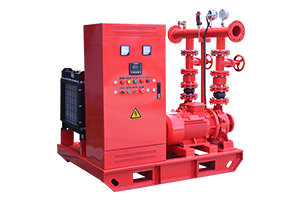How to Integrate a Fire Pump System with Your Building’s Fire Alarm System?
Fire pump systems play a crucial role in ensuring your building's fire safety by providing the necessary water pressure and flow during an emergency. However, to maximize their effectiveness, fire pump systems must be properly integrated with your building’s fire alarm system. This integration ensures that the fire pump operates when needed, responding automatically to alarms triggered by fire detection systems. In this article, we’ll explore the importance of integrating fire pump systems with fire alarm systems and the key steps for a successful setup.

Why Integration is Crucial
A well-integrated fire pump system and fire alarm system provide a unified response to fire emergencies. The fire alarm system detects smoke or heat and sends a signal to activate the fire pump, ensuring that water pressure is immediately available to suppress the fire. Without this integration, fire pumps may fail to operate at the right moment, leading to severe consequences. This integration also ensures compliance with fire safety regulations and standards, such as NFPA 20 and UL listings, which mandate that fire pumps are tested and automatically activated when needed.
Key Steps for Integration
-
Understand the Fire Alarm System’s Capabilities
Before starting, review the existing fire alarm system's specifications and ensure it is capable of communicating with the fire pump system. Modern fire alarm systems often have relay outputs that can trigger external equipment, including fire pumps. These systems must meet NFPA 72 standards to ensure reliability in emergency conditions. -
Install a Fire Pump Controller with Alarm Integration
The fire pump controller is the heart of the system, monitoring pressure and activating the pump when necessary. Integrate this controller with the fire alarm system so that the controller can receive signals to activate or shut down the pump based on fire alarm inputs. Make sure the controller is UL listed and NFPA 20 compliant to meet industry standards. -
Ensure Proper Communication Between Systems
Communication between the fire alarm system and the fire pump should be wired correctly to avoid any miscommunication or delays during an emergency. Typically, this involves using dedicated fire-rated cables to establish a secure and reliable connection. -
Program the System for Automated Response
The fire pump must be programmed to start automatically upon receiving an alarm signal. When smoke or heat is detected, the fire alarm system will send a signal to the fire pump controller to start the pump, ensuring that water is available immediately to fight the fire. -
Test the Integrated System Regularly
Integration isn’t a one-time setup. It is essential to regularly test both systems to ensure they work together effectively. Follow NFPA 25 guidelines for inspecting and testing fire pump systems and fire alarm integration. Conduct both manual and automated tests to verify that all components activate as intended.
Benefits of Fire Pump and Fire Alarm Integration
- Automatic Activation: Integration ensures that the fire pump activates automatically when the fire alarm system detects an emergency.
- Increased Reliability: A synchronized system increases reliability, reducing the risk of pump failure during a fire emergency.
- Regulatory Compliance: Proper integration helps meet safety standards and codes such as NFPA 20 and UL listings.
- Enhanced Fire Safety: Faster response times improve the chances of containing and extinguishing fires, ultimately saving lives and property.
Conclusion
Integrating a fire pump system with your building's fire alarm system is not just a smart decision—it's a necessity for ensuring optimal fire safety. By understanding the system's capabilities, choosing the right components, and ensuring proper installation and maintenance, you can ensure that your fire pump will perform its critical role when it’s needed most. Regular testing and compliance with industry standards will provide peace of mind, knowing that your building is equipped with a reliable fire protection system.
Make sure to consult with fire safety professionals or fire pump manufacturers to guide you through the process and ensure seamless integration.






